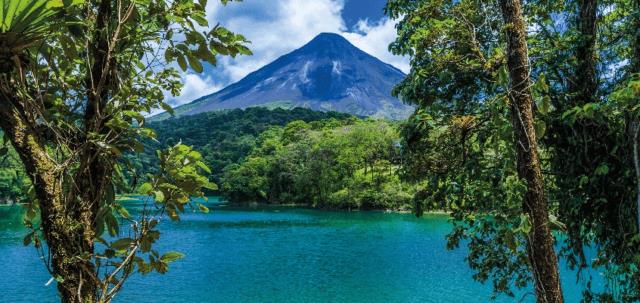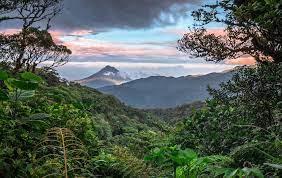
Costa Rica: The Greenest and Happiest Country In The World.
report this adTCRN STAFF Creating a Conscious alternative news network that we feel the world needs. Pura Vida!
Costa Rica is a small country, with an average income and a prosperous standard of living. It is known for the expression“ Pura Vida ” that refers to the art of appreciating simplicity, happiness and optimism, and this seems to describe the social system based on peace and security that characterizes the country .
But the most representative element of Costa Rica does not rest on its peaceful character (even if it is one of the few states in the world without an army), if not on having made its flag green. In recent years, Costa Rica has become a small ecological power in the region and is making its green condition a differential brand, promoting ecological industries and sustainable tourism.
TIP: Get updates on upcoming Costa Rican Retreats & Events by joining our newsletter . Don't miss out on what's happening around you! Click here .
Green economy model
But according to Costa Rica, its green project does not have the sole objective of conserving its biodiversity and developing a differentiated country brand. With this project, Costa Rica seeks to open the way for other nations to curb greenhouse gas emissions and protect their natural spaces, thus avoiding climate change and its devastating consequences. But this leads us to the following question: is Costa Rica really a role model for the rest of the nations?
Costa Rica is known worldwide for developing a green economy model that has been able to successfully combine economic development with the conservation of the biosphere and the reduction of carbon emissions.
The country has an area 10 times smaller than that of Spain, while it is home to 5% of all the world's biodiversity. In addition, 25% of its territory is protected and 50% of it is occupied by forests.
Stop deforestationWhat's more, it is one of the few countries that have managed to stop deforestation. While this has only increased in areas such as Brazil or Bolivia, Costa Rica has gone from having 21% of the territory covered by forests in 1987, to the current levels of 50%. This has been the consequence, in large part, of a system of environmental protection and payments for environmental services.
Payments for environmental services
Its system of payments for environmental services consists of a model of taxes on fuels that are destined to a special fund for natural conservation. This fund is known as the Costa Rican Forest Financing Fund, which rewards farm owners who decide to conserve natural spaces or implement programs to help strengthen them. In addition, companies that want to compensate for the negative externalities of their economic activities on the environment also voluntarily participate in this fund.
But this is not all, in 2015 99% of Costa Rican energy already came from renewable sources, up to 80% coming from hydraulic energy, and by 2050 they hope to be a completely carbon-free country, in line with the Paris Agreement. and the United Nations Sustainable Development Goals.
And that is only a small part of all the projects that seek to make Costa Rica a sustainable country. The government recently approved a plan for geothermal plants that seek to promote volcanic geothermal energy and that of a hydroelectric plant called Reventazon, which aims to provide power to more than half a million houses and supply electricity to around a quarter of the country's inhabitants.
Champions of the Earth awardAs a result of these efforts, Costa Rica received the highest environmental award from the United Nations in 2019, the Champions of the Earth award. The United Nations Environment Program awarded him the recognition of the category of Political Leadership given his work in the protection of nature and his commitment to policies to combat climate change.
According to Inger Andersen, executive director of the United Nations Environment Program:“Costa Rica has been a pioneer in the protection of peace and nature, and is an example for the region and for the world. Climate change requires urgent and transformative action on the part of all of us and, with its ambitious plans to decarbonize the economy, Costa Rica is up to that challenge”.
Costa Rica has not stood out only for its environmental policies, but for its combination of these with economic policies, and although sustainability is commonly associated with the decline in development, there is nothing further from the Costa Rican reality. Its projects for a sustainable economic and social model have not been at odds with economic development.
Economic growthSince 2000, the economy has grown at an annual rate of 4%, a growth well above that of most Latin American nations or those belonging to the OECD. And if we take welfare measurement variables other than GDP, the results are even better. While Costa Rica is located at number 76 in the ranking of GDP worldwide, in terms of prosperity it is in position 29 in the ranking, being the second most prosperous country in all of South America, only surpassed by Uruguay and being very near this.
In addition, it has the third highest life expectancy in the Latin American continent, even above the United States. And if instead of taking data on economic well-being or prosperity, we take into account the well-being of the population, Costa Rica recently reached first place in the Happy Planet Index for the third time in a row, making it the country with the happiest inhabitants of the earth.
Some stability problemsSo far, the country's situation seems idyllic, and although Costa Rica has been recognized as one of the leading nations in the combination of economic growth and sustainability, it still presents problems that threaten its stability. There are three main problems that threaten the well-being of Costa Rica, many common to other regions of the world: debt, violence and populism.
In the last 10 years, Costa Rican public debt in terms of GDP has doubled and the country closed 2019 with a fiscal deficit of almost 7%. And while 1 in 3 dollars of public spending is already used to pay the debt, there is not much room to raise taxes. These, especially taxes on electricity and fuels or on corporate profits, are already among the highest in the world.
And all this is combined with already high unemployment rates, which are touching maximum as a consequence of the pandemic, which has only exacerbated the problem. Since much of the economy was based on sustainable tourism, unemployment has grown from 12% to 24% and the situation is increasingly unstable.
Social mobilizationsIn order to finance the crisis, President Carlos Alvarado requested a tax increase that would allow him to negotiate a loan with the IMF, a proposal that has led to the most massive wave of social mobilizations in decades. Since September 30, the mobilizations have been throughout the country and although Alvarado announced on October 4 that he would not go ahead with the IMF's initial proposal, the protests have not stopped.
Furthermore, Costa Rica is suffering an unprecedented wave of violence. Being a historically peaceful country and without even having military structures, it has not been able to contain Central American violence. The country is in one of the most violent regions in the world, ravaged by drug trafficking. And although the situation is not close to that of some neighboring countries such as Nicaragua, Costa Rica continues to be in the middle of one of the main drug routes worldwide.
The third problem is a wave that is already hitting the world: populism. The first round of the last elections was not won by current president Carlos Alvarado, but by Fabricio Alvarado, a well-known evangelical pastor with a populist discourse and a stance radically against many individual freedoms, such as equal marriage. In the second round, his percentage of vote reached 30%, and although it is not enough to win the elections, it serves as a warning for what could happen at the political level in the coming years.
Many challenges to faceIn conclusion, it is undeniable that Costa Rica still has many challenges to face, but these, like economic development, do not seem directly linked to its power as a sustainable country. Even with debt problems and being in one of the most conflictive regions on the planet, Costa Rica has managed to carve out a niche alongside the most advanced nations in environmental leadership to achieve clean and environmentally friendly nations.
Now we can only see if the measures against the consequences of the pandemic follow the green line of previous Costa Rican political projects. And with this, I leave it up to you to decide if Costa Rica is an example of sustainable development and a model for the future for the rest of the nations or, on the contrary, if we must continue to seek a new path to a greener and healthier world.

Legal Disclaimer:
MENAFN provides the
information “as is” without warranty of any kind. We do not accept
any responsibility or liability for the accuracy, content, images,
videos, licenses, completeness, legality, or reliability of the information
contained in this article. If you have any complaints or copyright
issues related to this article, kindly contact the provider above.


















Comments
No comment